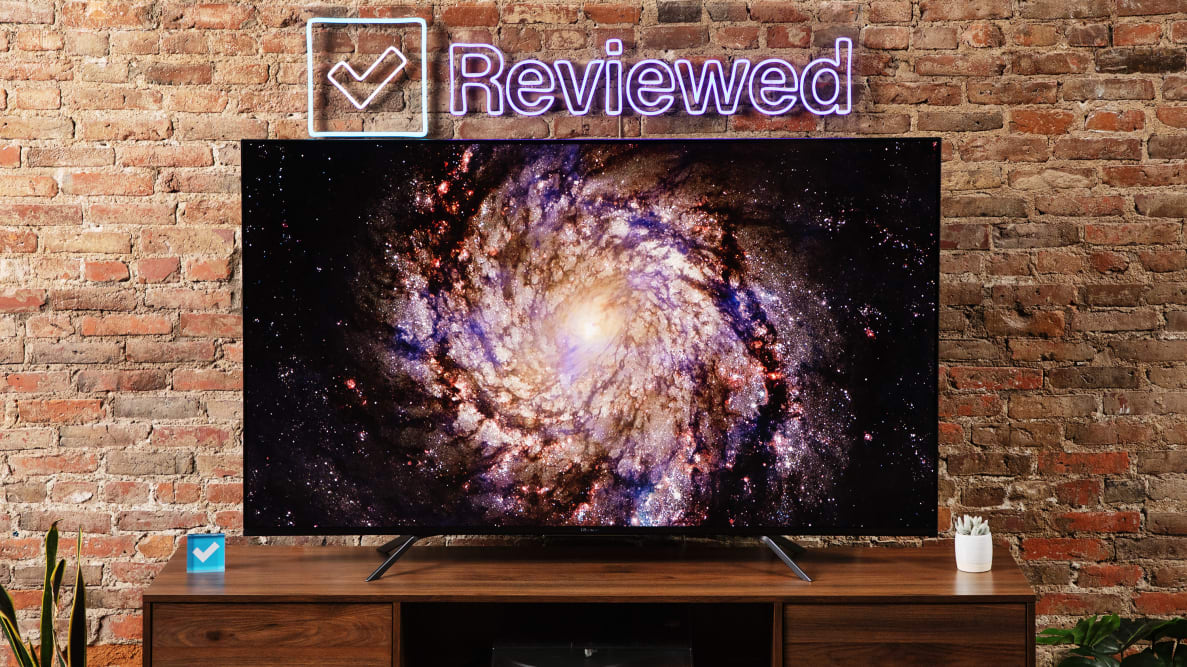Pros
-
Excellent bright-room option
-
Class-leading gaming features
-
Fast, easy-to-use smart platform
Cons
-
Light bloom
-
Picture processing issues
For an eminently fair price, the U7H delivers the brightest picture you’ll find for under $700. It's got a longer list of gaming features than any other TV in this price range, including a 120Hz panel. With Google TV in tow, pretty much any app you can think of is right at your fingertips, and the software itself moves lickety split.
There are, of course, some shortcomings. The U7H suffers from severe light bloom when viewed off-axis, and Hisense’s picture processing struggles to upscale sub-4K content as cleanly as some of its competitors.
Still, the amount of value here is remarkable. The U7H is great for daytime viewing, nighttime viewing, and gaming; a true jack of all trades. If you’ve had your sights set on the Hisense U6H, keep reading—you may decide that the U7H is even more worthy of your money.
About the Hisense U7H
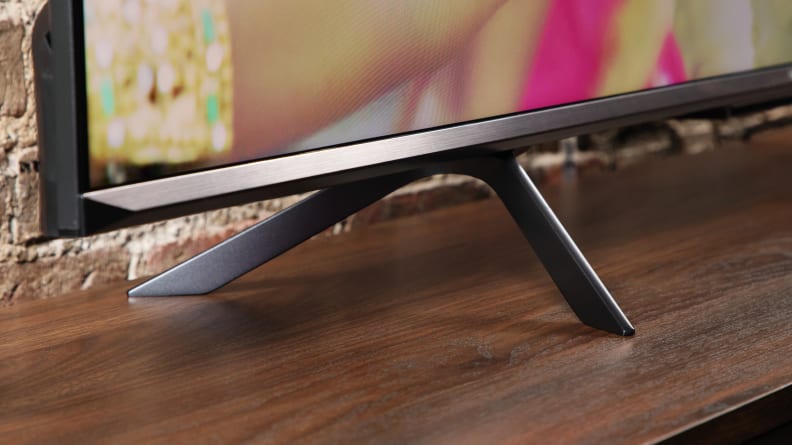
The U7H has both a wide and narrow position for its feet.
The Hisense U7H is available in four sizes ranging from 55 inches all the way up to 85 inches. We received a 65-inch unit on loan from Hisense.
The U7H has seen a significant price drop in the months since its initial release. I’ve reported its current sale prices below, but you may find that they’re slightly different depending on where and when you shop. Broadly speaking, I don’t expect the U7H to get much more expensive than it is right now, particularly as we move into the holiday season.
Here’s how each model compares:
- 55-inch (Hisense 55U7H), $499.99
- 65-inch (Hisense 65U7H), $699.99
- 75-inch (Hisense 75U7H), $949.99
- 85-inch (Hisense 85U7H), $1,799.99
While we don’t expect there to be major differences in performance from one size to the next, each model is equipped with a different amount of dimming zones. Despite the fact that the number of zones tends to increase proportionally to a TV’s size, a difference in zone count could spell slight differences in how they perform, particularly when it comes to contrast. Hisense has reported that its 75-inch model features 120 dimming zones.
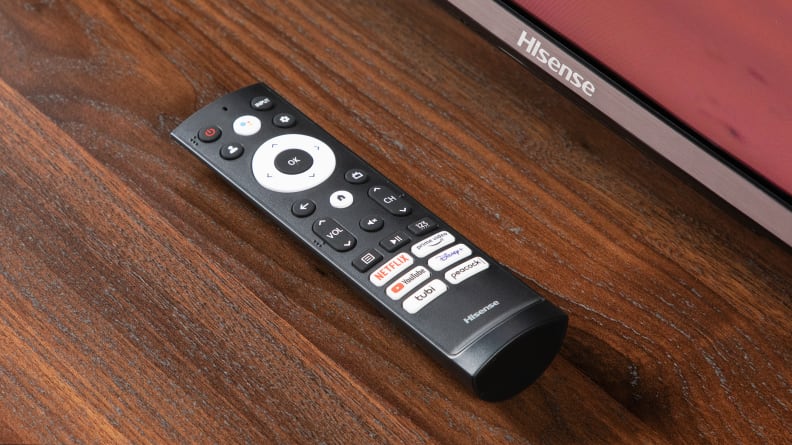
The TV's remote works well and includes a built-in mic for voice control.
Here’s a rundown of the U7H’s key hardware and software specifications:
- Resolution: 4K (3,840 x 2,160)
- Display type: Full-array LED with local dimming and quantum dots (VA-style panel)
- HDR support: Dolby Vision, HDR10+, HDR10, HLG
- Dolby Atmos: Yes
- eARC support: Yes (HDMI 3)
- Native refresh rate: 120Hz
- Smart platform: Google TV
- Color: DCI-P3 color space/10-bit chroma resolution
- Variable Refresh Rate (VRR): Yes
- Auto Low Latency Mode (ALLM): Yes
- Processor: Hi-View Engine 4K
- Other features: AMD FreeSync, Apple AirPlay, Apple HomeKit, Amazon Alexa, Google Assistant, Google Chromecast, ATSC 3.0
The U6H comes with a new version of Hisense’s standard remote control, which features a handful of dedicated app buttons and a built-in microphone for voice commands. The remote harmonizes well with the TV’s software, but you’ll first need to familiarize yourself with some of the button’s symbols.
The TV’s overall design isn’t particularly fancy, but its materials feel sturdy and there’s ample clearance beneath the panel for a soundbar. Perhaps the most useful aspect of the TV’s design is its available stand slots; the U7H’s feet can be configured two ways, allowing folks to set the TV up on a narrower surface. There are also basic cord management clips on the back of the feet.
Connectivity
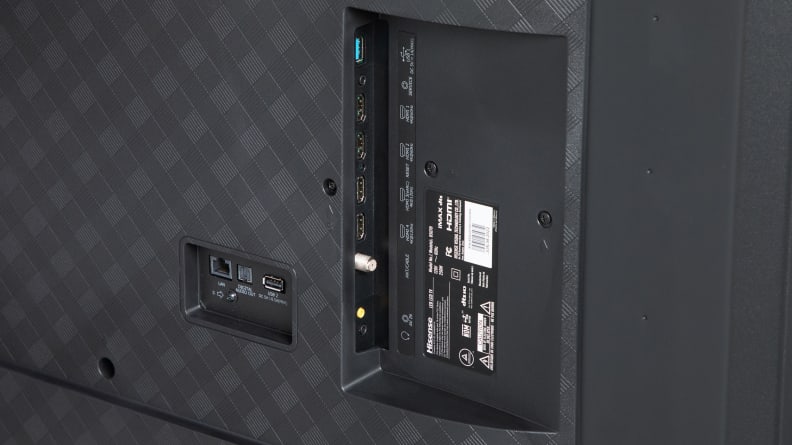
Two of the four HDMI ports are 2.1 (one with eARC).
The U7H features plenty of connectivity options. Gamers will appreciate the TV’s inclusion of two HDMI 2.1 inputs that support 4K gaming at 120Hz (though one of these ports also serves as the dedicated eARC port).
Here’s what you’ll find in a cutout on the rear of the panel:
- 2x HDMI 2.1 (4K @ 120Hz, 1x HDMI ARC/eARC)
- 2x HDMI 2.0 (4K @ 60Hz)
- 1x USB 3.0
- 1x USB 2.0
- RF connection (cable/antenna)
- Ethernet (LAN) input
- Digital audio output (optical)
- Composite input (with adapter)
- 3.5mm audio jack
Performance Data
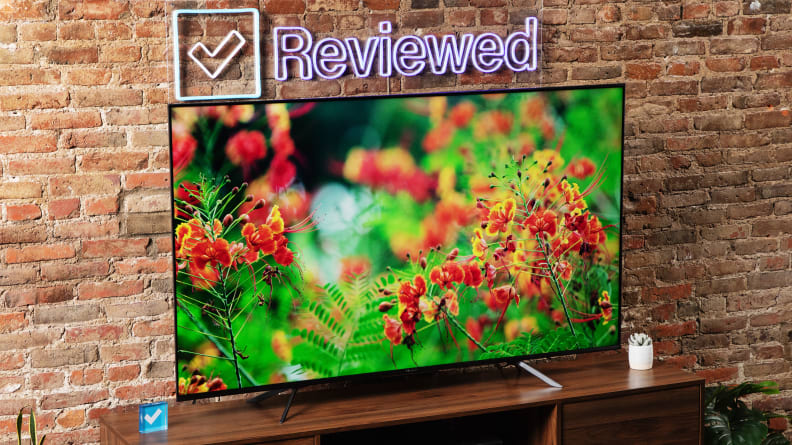
The Hisense U7H combines great color with a bright picture.
Before testing each TV, we make sure the panel is on and receiving a continuous signal for at least 2 hours. Our 65-inch U7H received this standard warm-up time before any readings were taken. In addition, the TV received the latest firmware updates at the time of testing.
For both SDR and HDR tests, we’re using the U7H’s Filmmaker picture mode. We’ve chosen this setting because of its accuracy, but performance may vary depending on which picture mode is enabled. For example, you might experience a brighter picture with a different mode enabled, but it may negatively affect color temperature and overall color accuracy.
For additional context, I also ran some tests in the TV’s Theater Day picture modes, but those results are not reported below.
To get a sense of the TV’s average performance, we use a standard ANSI checkerboard pattern for most of our basic contrast tests. We also use white and black windows ranging from 2% to 90% to test how well the contrast holds up while displaying varying degrees of brightness.
Our peak brightness measurements are taken with sustained windows to represent the TV’s peak brightness over a sustained period of time. Specular highlights (like brief flashes of reflected light) might reach higher brightness levels, but not for sustained periods of time.
All of our tests are created with a Murideo Seven 8K signal generator and tabulated via Portrait Displays’ Calman Ultimate color calibration software.
I'll expand on our test results throughout the review, but for now, here are some key takeaways:
- HDR contrast (brightness/black level): 653.6 nits/0.086 nits (ANSI checkerboard)
- SDR contrast (brightness/black level): 649.1 nits/0.087 nits (ANSI checkerboard)
- HDR peak brightness (sustained): 1,013 nits (20% white window)
- HDR color gamut coverage (DCI-P3/10-bit): 93%
- SDR color gamut coverage (Rec.709): 100%
Before testing, I made sure to adjust the TV’s HDMI input setting to Enhanced. This was achieved by using the hamburger menu button (with three horizontal lines) on the remote control.
For both SDR and HDR tests, I disabled the TV’s Automatic Light Sensor, set the Local Dimming to High, and kept the Color Temperature at Low. In addition, the following settings were disabled: Motion Enhancement, Motion Clearness, Noise Reduction, Digital Noise Reduction, Active Contrast, Dynamic Tone Mapping, and Low Blue Light.
During SDR tests, the Backlight Level was initially set to 100 to get a sense of the U7H’s peak SDR brightness. I also ran SDR tests at the default Backlight Level of 80.
What we like
A fantastic budget-friendly pick for bright-room viewing
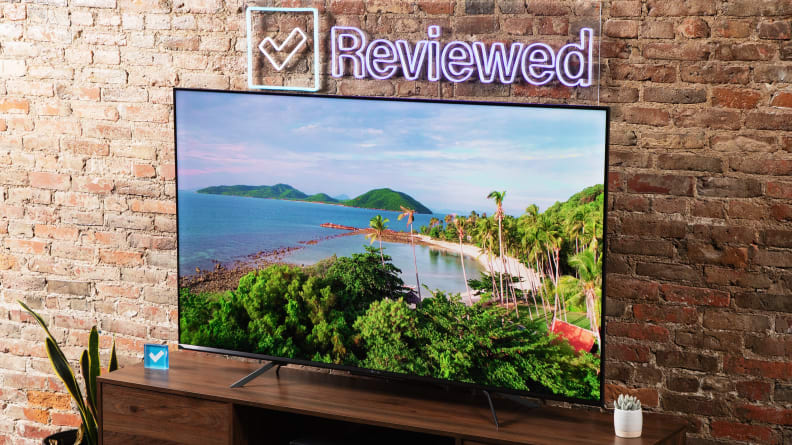
For the price, the U7H delivers the brightest picture you can get.
The U7H is the brightest TV in this price range that I’ve seen all year. Its average ANSI picture brightness is right around 650 nits in both SDR and HDR—higher than the similarly priced TCL 5-Series, which only scrapes 550 nits of ANSI brightness in HDR.
The U7H’s specular highlights are even more impressive. Our lab tests reveal that small, concentrated pockets of brightness are capable of cracking the 1,000-nit mark in HDR. For reference, the TCL 5-Series tops out at around 700 nits for its HDR highlights.
If your living room is relatively bright, the U7H will hold up quite well, so long as it’s not sitting directly in a sunbeam. Dark-room viewing is impressive, too, thanks in large part to the U7H’s ability to get bright. Its black levels aren’t as deep as some of its competitors, and the U7H has the tendency to lift them when dark areas of the picture are competing with bright elements. But throughout my time with the U7H, I found its performance to be suitable for both bright and dark viewing environments.
Another shoutout is in order for the U7H’s quantum dot-enhanced colors, too. It covers about 93% of the HDR color gamut (DCI-P3), which is slightly better than the results we measured on the U6H, although not quite as impressive as the U8H. Still, there’s enough volume for the TV’s colors to really pop in HDR—typically not an easy feat for a TV in this price range.
The best gaming TV in its price bracket
In recent years, shopping for a mid-range gaming TV that doesn’t painfully cut corners has been a tough task. While you might be able to find a TV that supports both Variable Refresh Rate and Auto Low Latency Mode for right around $600, netting HDMI 2.1 inputs that support 4K gaming at 120Hz usually requires a commitment of $800 to $1,000. Take the TCL 5-Series, for instance: While it offers VRR and ALLM, its panel is limited to 60Hz, so 4K gaming at 120Hz is out of the question. It’s all part of the compromise of buying an affordable TV.
But the U7H is a different story. Its panel features a native 120Hz refresh rate, and two of its HDMI ports support 4K gaming at 120Hz. Broadly speaking, its gaming support is on par with the step-up Hisense U8H, and the U7H costs about $300 to $400 less.
Simply put, there’s no better gaming TV on the market today in its price range. The only minor issue with the TV’s gaming support is that one of its 4K/120Hz-enabled ports also functions as the TV’s dedicated eARC port. If you own two next-gen gaming consoles and an eARC-enabled soundbar, one of the consoles will have to ride one of the TV’s limited 4K/60Hz ports, or go through your soundbar if it happens to have a capable HDMI in. To secure slightly better gaming features, you’d have to spend more on something like the TCL 6-Series.
Fast, easy-to-use smart features
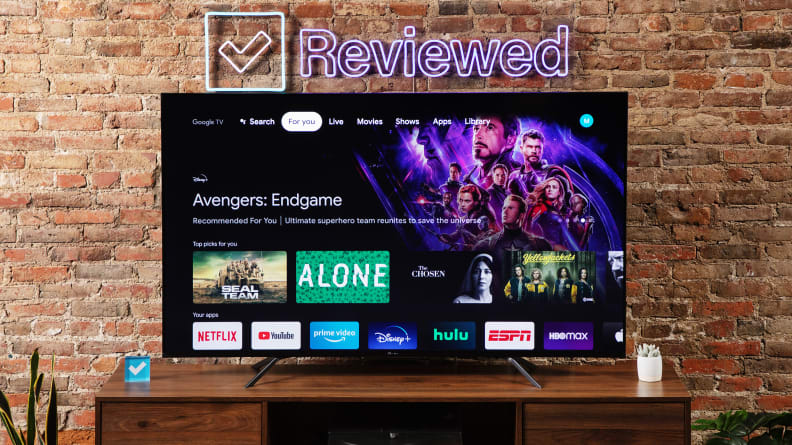
Google TV's quick performance continues to impress, but there are more sponsored ads than we'd like.
Like a number of Hisense and Sony TVs this year, the U7H comes with the Google TV smart platform built right in. A successor to Android TV, Google’s software is easy to pick up and use on the fly, and navigation is quite zippy.
As with all smart platforms, you’ll quickly learn to navigate around a constant stream of sponsored content. (The only smart platform that limits ads to a noticeable degree is Roku.)
That said, its app support is robust and there’s virtually no slowdown to speak of.
What we don’t like
So-so uniformity and off-axis light bloom
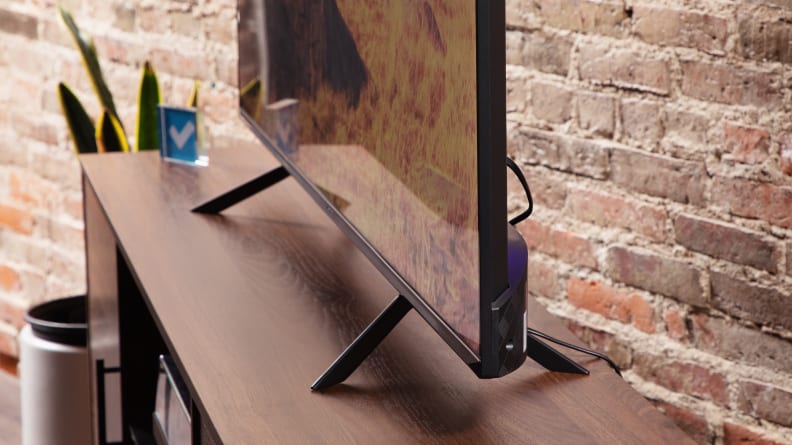
Off-axis performance isn't as good as similarly-priced competitors like the TCL 5-Series.
Every panel is different, so there’s no guarantee that our U7H will look the same as anyone else’s, but it’s worth noting that our U7H exhibited some not-so-great uniformity issues. While not visible often, the U7H struggled to display uniform neutral gray tones—from near black to light gray—without revealing dark blotches. The effect was especially pronounced during moments of transition (like when an app splash page is on the screen or when you’re waiting for content to load).
One thing that will be noticeable on pretty much all U7H models (regardless of panel) is light bloom. While the U7H is equipped with a perfectly adequete amount of local dimming zones for a TV in its price range, there aren’t as many as you’ll find on a higher-end mini-LED TV, like the Hisense U8H. As a result, there are often clouds of blue-tinted light surrounding bright picture elements surrounded by darkness (like title cards and subtitles).
This is especially noticeable when you’re viewing from an off-axis position; if you stray just twenty to thirty degrees away from a head-on angle, you’re bound to notice the light bloom. Because of this, I wouldn’t recommend the 75- or 85-inch versions of the U7H if you plan on using them for group viewings. The 75-inch U8H is a much safer investment for wider viewing areas.
A few picture processing problems
Unfortunately, this criticism is one that I’ve gotten used to writing whenever I cover a Hisense TV: The U7H suffers from a handful of picture processing-related issues that might distract viewers who are predisposed to seeing them.
Like the Hisense U8H (and last year’s U7G), the U7H displays some unfortunate red-tinted color fringing on characters and objects in motion. The effect is most noticeable along the edges of lightly-colored narrow objects (like brooms and swords) and alongside people's hairlines. The artifacts dissolve away as quickly as they appear, but with certain scene lighting, they can be majorly distracting.
The color fringing is at its worst while streaming sub-4K content in SDR from a platform like Netflix. It’s still visible in HDR, but it’s not as pronounced when the TV isn’t working to upscale content to 4K.
Setting aside the color fringing, the U7H struggles to upscale 720p or 1080p content across the board. Cable TV, YouTube videos, and over-the-air broadcasts don’t look that bad, but there’s far more artifacting going on than what you can expect to see from a mid-range Sony TV like the X80K.
Picture processing is one area where Hisense still lags behind brands like Sony, Samsung, and LG. If Hisense can improve on some of this in the coming years, its future mid-range offerings will be tough to beat.
Should you buy the Hisense U7H?
Yes, it’s one of the best TVs in its price range
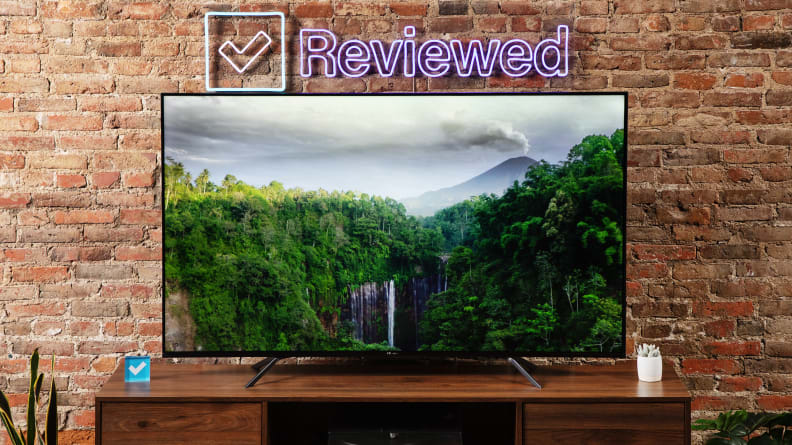
Hisense has again released a TV that outperforms its price.
This year, no 55- or 65-inch TV in the $400 to $700 price range offers as much versatility as the U7H. Its class-leading brightness makes it a great pick for daytime viewing. It’s class-leading gaming support makes it the best choice for gamers on a budget. Its overall contrast, Dolby Vision support, and robust smart platform make it a good fit for movie night, too.
In fact, the U7H is so much better than the U6H in all of these use cases that one would be hard pressed to opt for the latter—and I really like the U6H. Right now, the 55-inch U7H is only about $70 more than the 55-inch U6H. If you can afford the jump, I wouldn’t think twice about it.
If you’re not a serious gamer, prefer Roku instead of Google TV, or expect to occasionally have people watching off to the sides, the TCL 5-Series is probably the safer choice. But you’d be leaving the U7H’s bright-room benefits on the table, which might not be the wisest thing to do if your living room is plenty sunny.
If Hisense’s picture processing woes frighten you, the next best choice is the TCL 6-Series. Unfortunately, it's about $200 to $300 more expensive than the U7H. If you’re in the market for a 75- or 85-inch TV, however, the investment might be worth it, as the 6-Series also has a better handle on light bloom due to its mini-LED backlighting.
The reality is that I don’t expect very many people to be bothered by the U7H’s processing-related shortcomings. The U7H is one of those rare TVs that feels like a fair deal. It’s by no means perfect, but for the price, it’s rather shocking how well-rounded it is. In a year full of impressive Hisense TVs, the U7H might be the best deal of them all.
The product experts at Reviewed have all your shopping needs covered. Follow Reviewed on Facebook, Twitter, Instagram, TikTok, or Flipboard for the latest deals, product reviews, and more.
Prices were accurate at the time this article was published but may change over time.
Meet the tester
Michael Desjardin graduated from Emerson College after having studied media production and screenwriting. He specializes in tech for Reviewed, but also loves film criticism, weird ambient music, cooking, and food in general.
Checking our work.
Our team is here to help you buy the best stuff and love what you own. Our writers, editors, and experts obsess over the products we cover to make sure you're confident and satisfied. Have a different opinion about something we recommend? Email us and we'll compare notes.
Shoot us an email
